Dangers of Volcanic Ash
Travel Safety Threat
Damage in Flight
Damage on the Ground
North Pacific Air
Travel
Ring of Fire
Volcano Ground Observatory
Aircraft/Pilot Limitations
Remote Sensing Detection
GOES-Visible/Thermal IR
NOAA-AVHRR
EOS AURA -MLS/TES/OMI
Monitoring
and Warning
ICAO
WMO/NOAA
VAAC
ATC
Air Carrier Operation
Flight Crew Advisories
METAR
PIREPS
SIGMETS
References
Home
|
|
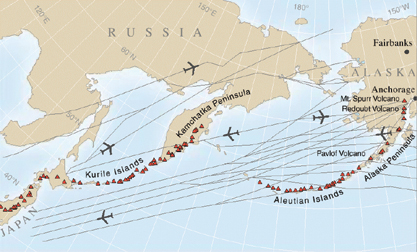 |
|
"PERILOUS PATHS. Flight routes over the North
Pacific to and from east Asia pass over or near about 100 Alaskan,
Russian, and Japanese volcanoes (red triangles)."
Travel Safety Threat |
Since its inception, commercial air travel has
been noted for maintaining a very high standard of passenger safety. People around
the world journey thousands of miles every day of the year by air for
business or personal ventures to an expected, uneventful arrival at their intended
destinations. Both these professional, highly trained air transport pilots
and the high tech machines that they fly do their jobs and do them well
time
and time again. Yet, there are situations brought about by various
environmental hazards that are elusive to onboard radar systems which
could
place commercial jet aircraft in harms way unexpectedly. The focus of this
report is about one such dangerous environmental hazard to commercial jet
travel known as
volcanic ash.
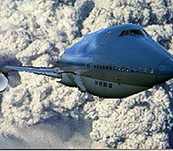 These
ash cloud
plumes, transported by atmospheric
winds are at the very least, responsible for major disruptions to air traffic and pose a
potentially serious threat to aircraft hundreds of miles away from the
origin of its eruption. They pose costly and potentially deadly
dangers to aircraft unwittingly caught in them and then obligated to fly
through them. Hence, this is a major concern when one considers the fact that there are 1,500 known
volcanoes in
the world and approximately 600 of them are considered to be active. In
addition, it is estimated that between 55-60 volcanoes out of the
identified active group will erupt each year and what is most significant,
8-10 of these eruptions will reach cruising altitudes of commercial jet
aircraft. To put the magnitude of one such event in perspective, quoted
are statistics from ofcm.gov dated February 25,2004. "When Mt. St. Helens erupted in 1980,
the plume reached an altitude of 90,000 ft. in 30 minutes and was 50
miles wide. In 15 hours, the plume traveled 600 miles downwind. After 2
weeks, ash had circled the earth." These
ash cloud
plumes, transported by atmospheric
winds are at the very least, responsible for major disruptions to air traffic and pose a
potentially serious threat to aircraft hundreds of miles away from the
origin of its eruption. They pose costly and potentially deadly
dangers to aircraft unwittingly caught in them and then obligated to fly
through them. Hence, this is a major concern when one considers the fact that there are 1,500 known
volcanoes in
the world and approximately 600 of them are considered to be active. In
addition, it is estimated that between 55-60 volcanoes out of the
identified active group will erupt each year and what is most significant,
8-10 of these eruptions will reach cruising altitudes of commercial jet
aircraft. To put the magnitude of one such event in perspective, quoted
are statistics from ofcm.gov dated February 25,2004. "When Mt. St. Helens erupted in 1980,
the plume reached an altitude of 90,000 ft. in 30 minutes and was 50
miles wide. In 15 hours, the plume traveled 600 miles downwind. After 2
weeks, ash had circled the earth."
Over the past twenty years, there have been
approximately ninety such encounters between commercial jet aircraft and
volcanic ash.
 Seven of these encounters have caused either in-flight loss
of jet engine power or complete
engine flame-out. Thankfully, none of them
have resulted in crashes or fatalities. However, the effects of these far
reaching volcanic ash plumes in terms of commercial air travel safety,
costly aircraft damage received through all phases of flight and
costly
aircraft damage sustained while on the ground requires a total
volcanic ash avoidance solution. Therefore, the necessary steps to
accomplish such a goal will only be achieved through constant vigilance by
the use of reliable remote sensing techniques, by the use of
dedicated monitoring agencies and by the delivery of timely warnings to
air carrier operations center. Seven of these encounters have caused either in-flight loss
of jet engine power or complete
engine flame-out. Thankfully, none of them
have resulted in crashes or fatalities. However, the effects of these far
reaching volcanic ash plumes in terms of commercial air travel safety,
costly aircraft damage received through all phases of flight and
costly
aircraft damage sustained while on the ground requires a total
volcanic ash avoidance solution. Therefore, the necessary steps to
accomplish such a goal will only be achieved through constant vigilance by
the use of reliable remote sensing techniques, by the use of
dedicated monitoring agencies and by the delivery of timely warnings to
air carrier operations center.
Damage in Flight
As previously stated, aircraft through all phases of flight,
which includes cruise
altitude, taking-off and landing have been severely damaged from
encounters with these drifting volcanic ash plumes. Ergo, the ramifications of flying through
these ash clouds are serious and extensive; the list includes damage to
critical aircraft components including lift surfaces, windshields and
engines. This damage endangers passengers through the potential loss of
aerodynamic lift, loss of engine power, visibility and degraded
communications between flight crews and air traffic control centers. According to the International Airways Volcano Watch (IAVW), th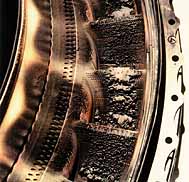 e
effects upon jet engines, in particular, by ingesting this material
containing mostly silicates is dangerous primarily because of the melting
point of the ash is approximately 1100 deg C while the operating
temperature of high bypass jet engines are around 1400 deg C. The ash,
therefore, does not simply blow through the engines as dust/sand tends to,
but Melts in the hot section (picture to the right-engine damage from ash
ingestion) and FUSES randomly on fuel nozzle guide vanes
and turbine blades." Even limited exposure will cause degraded
performance and the worst case scenario with continued exposure will incur
a total engine failure condition known as "flameout". e
effects upon jet engines, in particular, by ingesting this material
containing mostly silicates is dangerous primarily because of the melting
point of the ash is approximately 1100 deg C while the operating
temperature of high bypass jet engines are around 1400 deg C. The ash,
therefore, does not simply blow through the engines as dust/sand tends to,
but Melts in the hot section (picture to the right-engine damage from ash
ingestion) and FUSES randomly on fuel nozzle guide vanes
and turbine blades." Even limited exposure will cause degraded
performance and the worst case scenario with continued exposure will incur
a total engine failure condition known as "flameout".
This ash is abrasive and has clogged pitot-static systems which are critical inputs to
various aircraft user systems such as navigation equipment, flight controls and
pressurization systems. Windshields and landing light lenses have been
virtually "sandblasted" to a frosty finish thus rendering their visibility useless.
Sulfur Dioxide gas (SO2), another byproduct of volcanic activity is extremely corrosive
and extremely damaging to all aircraft metal components.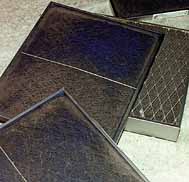 Crews and passengers alike will inhale this noxious material as it is drawn into the
flight deck and cabin compartments by the jet's air conditioning and
recirculation systems as evidenced by these ash-coated filters causing
environmental control damage. Once the
ash is ingested into the aircraft's air conditioning system, it will
travel to all interior spaces both above and below deck
infiltrating such critical areas as avionics cooling systems which
supplies necessary navigation instrument and computer ventilation to prevent
overheating. It also travels through circuit breaker and related
electrical service panels located throughout the aircraft necessary for
maintaining operation of essential systems.
Crews and passengers alike will inhale this noxious material as it is drawn into the
flight deck and cabin compartments by the jet's air conditioning and
recirculation systems as evidenced by these ash-coated filters causing
environmental control damage. Once the
ash is ingested into the aircraft's air conditioning system, it will
travel to all interior spaces both above and below deck
infiltrating such critical areas as avionics cooling systems which
supplies necessary navigation instrument and computer ventilation to prevent
overheating. It also travels through circuit breaker and related
electrical service panels located throughout the aircraft necessary for
maintaining operation of essential systems.
There are two issues here, obviously of paramount importance at all times
is passenger safety. Secondly, for any business
enterpri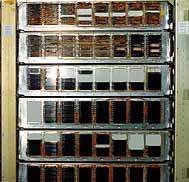 se to remain a viable entity,
one strives to control operating costs along the way. Yet, these very
encounters with volcanic ash (electrical panel damage-right) as presented in these images can easily reach
a staggering economic level in associated maintenance repair costs to the
air carriers in terms of millions of dollars per
aircraft per event. Estimates from the maintenance costs associated with
the 1989 KLM 747 encounter with the Redoubt volcano in Alaska exceeded
eighty
million dollars. se to remain a viable entity,
one strives to control operating costs along the way. Yet, these very
encounters with volcanic ash (electrical panel damage-right) as presented in these images can easily reach
a staggering economic level in associated maintenance repair costs to the
air carriers in terms of millions of dollars per
aircraft per event. Estimates from the maintenance costs associated with
the 1989 KLM 747 encounter with the Redoubt volcano in Alaska exceeded
eighty
million dollars.
Damage on the Ground
Let's not forget about aircraft ground damage either.
Timely warnings received by various air carrier operations can afford them
the opportunity to move aircraft from one location to another, thus
avoiding the situation all together. Improper wing and
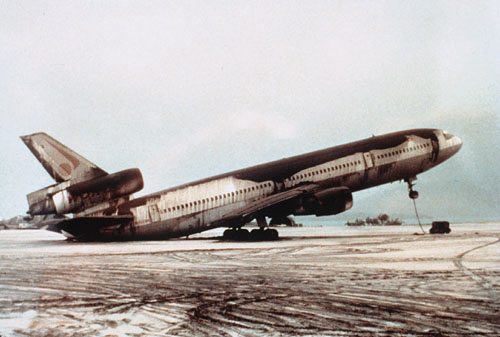 horizontal
stabilizer loading caused by the added weight of volcanic ash accumulation
on these surfaces can change the aircraft CG (center of gravity) and cause
a situation for rear-engine mounted aircraft known as tail tip as
evidenced in the photo of this DC-10. The end result is major structural
damage to the airframe requiring hundreds of hours in related repair
costs. According to a November 10, 2003 publication of Geological
Society , airlines have taken a hit of over $250 million worldwide as
a result of undetected volcanic ash in flight paths". Not included in this
figure are the lost revenue dollars per flight per day caused by extensive aircraft
downtime to accomplish these needed repairs. horizontal
stabilizer loading caused by the added weight of volcanic ash accumulation
on these surfaces can change the aircraft CG (center of gravity) and cause
a situation for rear-engine mounted aircraft known as tail tip as
evidenced in the photo of this DC-10. The end result is major structural
damage to the airframe requiring hundreds of hours in related repair
costs. According to a November 10, 2003 publication of Geological
Society , airlines have taken a hit of over $250 million worldwide as
a result of undetected volcanic ash in flight paths". Not included in this
figure are the lost revenue dollars per flight per day caused by extensive aircraft
downtime to accomplish these needed repairs.
|

 These
These
 Seven of these encounters have caused either in-flight loss
of jet engine power or complete
Seven of these encounters have caused either in-flight loss
of jet engine power or complete
 e
effects upon jet engines, in particular, by ingesting this material
containing mostly silicates is dangerous primarily because of the melting
point of the ash is approximately 1100 deg C while the operating
temperature of high bypass jet engines are around 1400 deg C. The ash,
therefore, does not simply blow through the engines as dust/sand tends to,
but Melts in the hot section (picture to the right-engine damage from ash
ingestion) and FUSES randomly on fuel nozzle guide vanes
and turbine blades." Even limited exposure will cause degraded
performance and the worst case scenario with continued exposure will incur
a total engine failure condition known as "flameout".
e
effects upon jet engines, in particular, by ingesting this material
containing mostly silicates is dangerous primarily because of the melting
point of the ash is approximately 1100 deg C while the operating
temperature of high bypass jet engines are around 1400 deg C. The ash,
therefore, does not simply blow through the engines as dust/sand tends to,
but Melts in the hot section (picture to the right-engine damage from ash
ingestion) and FUSES randomly on fuel nozzle guide vanes
and turbine blades." Even limited exposure will cause degraded
performance and the worst case scenario with continued exposure will incur
a total engine failure condition known as "flameout". Crews and passengers alike will inhale this noxious material as it is drawn into the
flight deck and cabin compartments by the jet's air conditioning and
recirculation systems as evidenced by these ash-coated filters causing
environmental control damage. Once the
ash is ingested into the aircraft's air conditioning system, it will
travel to all interior spaces both above and below deck
infiltrating such critical areas as avionics cooling systems which
supplies necessary navigation instrument and computer ventilation to prevent
overheating. It also travels through circuit breaker and related
electrical service panels located throughout the aircraft necessary for
maintaining operation of essential systems.
Crews and passengers alike will inhale this noxious material as it is drawn into the
flight deck and cabin compartments by the jet's air conditioning and
recirculation systems as evidenced by these ash-coated filters causing
environmental control damage. Once the
ash is ingested into the aircraft's air conditioning system, it will
travel to all interior spaces both above and below deck
infiltrating such critical areas as avionics cooling systems which
supplies necessary navigation instrument and computer ventilation to prevent
overheating. It also travels through circuit breaker and related
electrical service panels located throughout the aircraft necessary for
maintaining operation of essential systems.  se to remain a viable entity,
one strives to control operating costs along the way. Yet, these very
encounters with volcanic ash (electrical panel damage-right) as presented in these images can easily reach
a staggering economic level in associated maintenance repair costs to the
air carriers in terms of millions of dollars per
aircraft per event. Estimates from the maintenance costs associated with
the 1989 KLM 747 encounter with the Redoubt volcano in Alaska exceeded
eighty
million dollars.
se to remain a viable entity,
one strives to control operating costs along the way. Yet, these very
encounters with volcanic ash (electrical panel damage-right) as presented in these images can easily reach
a staggering economic level in associated maintenance repair costs to the
air carriers in terms of millions of dollars per
aircraft per event. Estimates from the maintenance costs associated with
the 1989 KLM 747 encounter with the Redoubt volcano in Alaska exceeded
eighty
million dollars. horizontal
stabilizer loading caused by the added weight of volcanic ash accumulation
on these surfaces can change the aircraft CG (center of gravity) and cause
a situation for rear-engine mounted aircraft known as tail tip as
evidenced in the photo of this DC-10. The end result is major structural
damage to the airframe requiring hundreds of hours in related repair
costs. According to a November 10, 2003 publication of Geological
Society , airlines have taken a hit of over $250 million worldwide as
a result of undetected volcanic ash in flight paths". Not included in this
figure are the lost revenue dollars per flight per day caused by extensive aircraft
downtime to accomplish these needed repairs.
horizontal
stabilizer loading caused by the added weight of volcanic ash accumulation
on these surfaces can change the aircraft CG (center of gravity) and cause
a situation for rear-engine mounted aircraft known as tail tip as
evidenced in the photo of this DC-10. The end result is major structural
damage to the airframe requiring hundreds of hours in related repair
costs. According to a November 10, 2003 publication of Geological
Society , airlines have taken a hit of over $250 million worldwide as
a result of undetected volcanic ash in flight paths". Not included in this
figure are the lost revenue dollars per flight per day caused by extensive aircraft
downtime to accomplish these needed repairs.